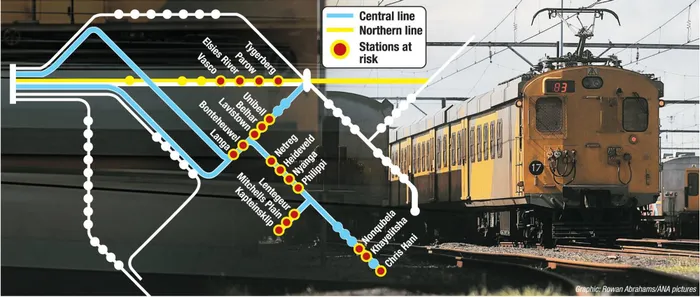‘Risky rail stations must be identified’

Steve Harris, general secretary of the United National Transport Union (Untu), which represents train drivers, said marking dangerous stations would help both Metrorail workers and commuters.
“As a responsible service provider, Metrorail should make that information available and speak about the red zone areas to the public. People expect to go to work safely with trains and also to get off safely at stations. If the public are aware that a certain train station is marked as a red zone, especially for those who get home late, they would be able to walk in groups.
“Our demand has been to revise the safety of all Metrorail staff, which includes train drivers and technicians.
“Technicians can’t work while looking over their shoulders or worrying what will happen next. Metrorail said they can’t create safe work spaces alone - they need help. That’s why the police were added, to ensure safety for everyone. So they must work together to ensure safety and security.”
Public Transport Voice, an organisation advocating for quality and equality in the South African public transport sector, said the marking of red zone stations must be done immediately as it would be easy to find a solution for each marked station.
“We have met with Metrorail many times, highlighting the problems, and given possible solutions to the problems. But up until this day they have not done anything, and we do want to help.
“On July 21 we sent an e-mail to Mr (Brian) Walker (regional manager), raising our concerns regarding the lack of security at Nolungile station, where commuters are daily victims of the criminals, especially during the evening hours.
"This was highlighted in our meetings with them and they said Nolungile had been identified as one of the crime hotspots, but nothing was done about it,” said Mthuthuzeli Dutyulwa, spokesperson for the group.
Dutyulwa said they were calling for beefed-up security, especially on the notorious central line with its crime hotspots.
“At most stations, CCTV cameras stopped working a long time ago. At stations like Netreg and Bishop Lavis, which are known as extremely dangerous, commuters are without lights at night and easily robbed.”
Metrorail spokesperson Riana Scott said they hadn’t yet specifically marked certain stations as red zones, but had drawn a map of stations that were experiencing various types of crime.
“The high crime areas for us correspond virtually 100% with EMS’s problematic areas such as Bonteheuwel, Netreg, Heideveld and Nyanga. These are the stations where our workers, such as technicians, have to be escorted, and drivers do not feel safe as some have been attacked and killed.”
She said the security guards’ job was to ensure the safety of the drivers, but their job had increased, and their protection service teams had arrested about 20 suspects since the beginning of July.
Cape Argus